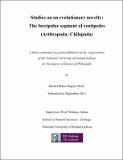| dc.contributor.advisor | Arthur, Wallace | |
| dc.contributor.author | Dugon, Michel Marie | |
| dc.date.accessioned | 2012-02-08T18:52:01Z | |
| dc.date.available | 2012-02-08T18:52:01Z | |
| dc.date.issued | 2011-11-29 | |
| dc.identifier.uri | http://hdl.handle.net/10379/2550 | |
| dc.description.abstract | The arthropod class Chilopoda comprises about 3500 described species of centipedes distributed across five living orders. A synapomorphic character of the class is the modified first trunk segment bearing a pair of sharp claw-like appendages (the forcipules), each one of which encases a venom system used to subdue prey and deter predators.
The forcipules of centipedes are the only example in the animal kingdom of an evolutionary transition from walking legs to venom-injecting appendages. In that sense, they represent a classic case of an evolutionary novelty. I propose here to investigate morphological, structural and behavioural aspects of this rather poorly known system.
First, a shape analysis on 43 species of centipedes was performed in order to investigate gross morphological variation of the forcipular apparatus between and within the living orders of the class. Additional scanning electron microscopy observations permitted the comparison of micro-structures on the surface of the forcipules.
Second, the venom system of four species of centipedes (one for each main order) was investigated using transmission electron microscopy. Then, the venom-production cycle was studied in more detail in the scolopendromorph Scolopendra subspinipes mutilans in order to confirm the merocrine nature of the venom gland.
Third, fluorescent microscopy and traditional light microscopy were used to observe and stage the development of three species of centipedes. This revealed the morphological specialisation of the forcipular structures coupled with the post-hatching development of the venom gland.
Finally, behavioural experiments on Scolopendra subspinipes mutilans demonstrated that the hunting behaviour of these centipedes is altered by the size of the prey and by the amount of venom available in the glands. | en_US |
| dc.rights | Attribution-NonCommercial-NoDerivs 3.0 Ireland | |
| dc.rights.uri | https://creativecommons.org/licenses/by-nc-nd/3.0/ie/ | |
| dc.subject | evolutionary novelty, Chilopoda, centipede, venom system, development, EVO-DEVO | en_US |
| dc.subject | Evolutionary novelty | en_US |
| dc.subject | Chilopoda | en_US |
| dc.subject | Centipede | en_US |
| dc.subject | Venom system | en_US |
| dc.subject | Development | en_US |
| dc.subject | EVO-DEVO | en_US |
| dc.title | Studies on an evolutionary novelty: The forcipular segment of centipedes (Arthropoda: Chilopoda) | en_US |
| dc.type | Thesis | en_US |
| dc.contributor.funder | Pr Brendan F. Keegan memorial studentship from Eli Lilly | en_US |
| dc.local.note | Centipedes (Arthropoda: Chilopoda) are opportunistic terrestrial predators. The most conspicuous morphological feature shared by all centipedes is probably the modified first trunk segment bearing a pair of strong venom claws. Each claw contains a fully functional venom apparatus. The present work focuses on this apparatus, using a broad approach which combined morphological, ultrastructural, behavioural and embryo-staining studies. | en_US |
| dc.local.final | Yes | en_US |
| nui.item.downloads | 555 | |


